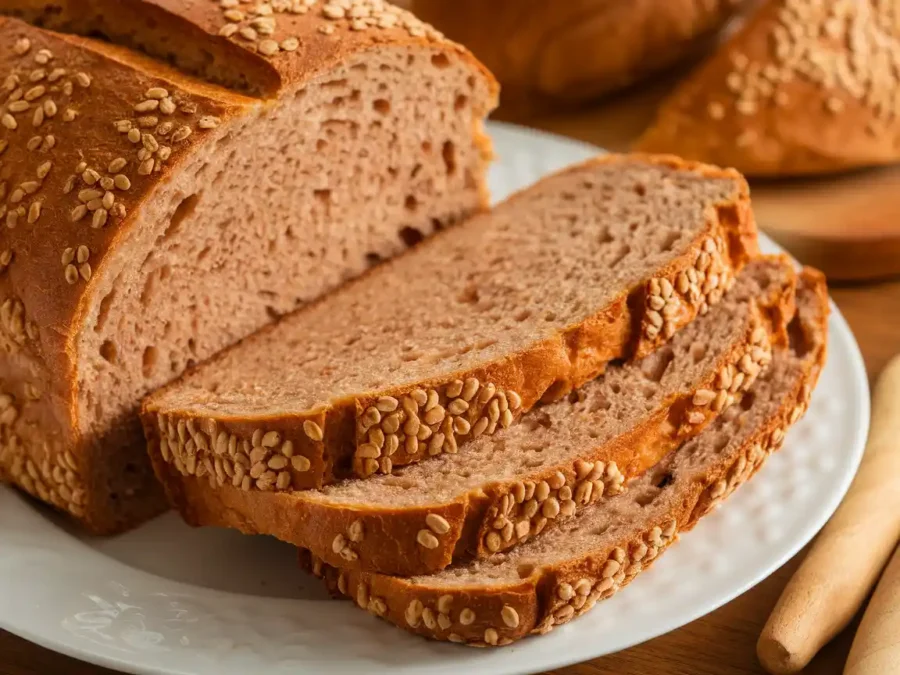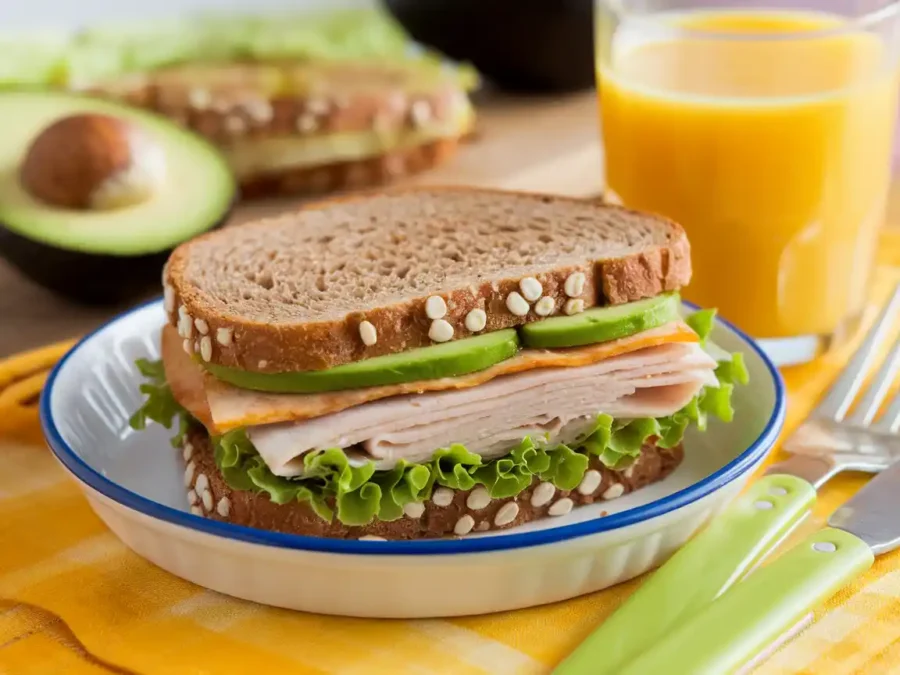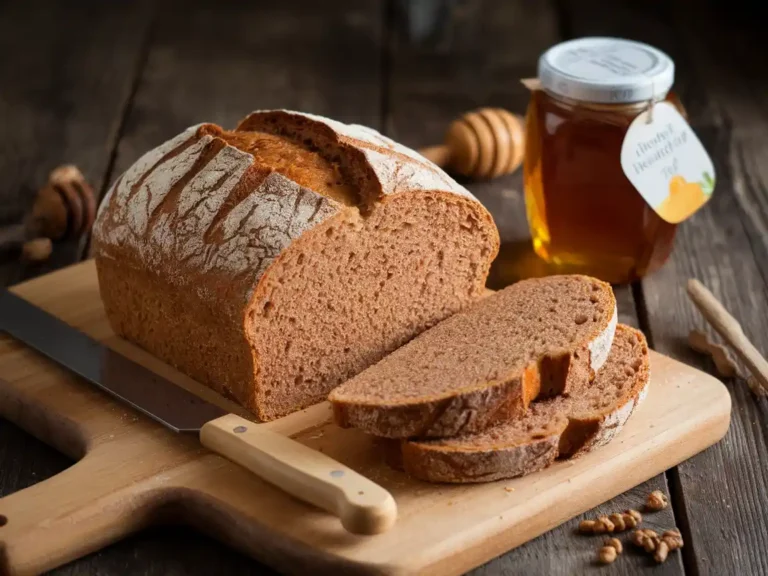When it comes to bread, few varieties have as much of a “halo effect” as honey wheat bread. You see it in grocery stores, on Instagram-worthy sandwich boards, and even touted in health-conscious recipes. But let’s get real how healthy is it, really? Can it stand tall against its competitors in the bread aisle, or is it just another loaf wearing a disguise? Let’s dive in, slice by slice, to uncover the truth about honey wheat bread.
Table of Contents
Introduction to Honey Wheat Bread
Honey wheat bread has a charming reputation. The name alone makes it sound sweet, wholesome, and downright nutritious, doesn’t it? At its core, this bread combines wheat flour with the natural sweetness of honey. But beyond the name, what does honey wheat bread bring to the table?
The bread is often marketed as a healthier alternative to white bread, claiming benefits like added fiber, fewer artificial ingredients, and a more satisfying flavor profile. But does it really live up to these claims, or is it more about clever branding than actual nutrition?
The answer isn’t as simple as a “yes” or “no.” Instead, it’s a mix of ingredients, processing, and personal dietary goals. Let’s break it down in detail to get a clearer picture.
Nutritional Profile of Honey Wheat Bread
A quick glance at a loaf of honey wheat bread might leave you feeling optimistic. But as always, the devil’s in the details. Let’s take a closer look at what’s actually in a slice.
Key Ingredients in Honey Wheat Bread
The first thing to examine is the ingredient list. High-quality honey wheat bread typically includes:
- Whole wheat flour: A rich source of fiber, which is great for digestion.
- Honey: A natural sweetener that adds flavor without refined sugars.
- Yeast and water: Essential for the bread’s texture and rise.
- Additional grains or seeds (in some varieties): These enhance its nutritional value.
However, not all honey wheat bread is created equal. Some brands use enriched wheat flour instead of whole wheat, stripping away much of the fiber and nutrients. To spot a winner, always look for “100% whole grain” on the label.
How It Differs from Regular Wheat Bread
What sets honey wheat bread apart from standard wheat bread? It’s simple: the honey. The addition of honey adds a touch of sweetness, which makes the bread more palatable especially for kids or those transitioning from white bread.
However, the added sweetness might come with a catch: higher sugar content. While honey is natural, it’s still sugar, so moderation is key.
Health Benefits of Honey Wheat Bread

Alright, let’s talk positives. Honey wheat bread isn’t all smoke and mirrors; it does have some genuine health perks.
Rich in Fiber for Digestive Health
If made with whole wheat flour, honey wheat bread is an excellent source of dietary fiber. This fiber can help:
- Keep your digestive system running smoothly.
- Lower cholesterol levels.
- Stabilize blood sugar levels (making it a better choice for diabetics than white bread).
Fiber works like a broom for your insides, sweeping away the bad and keeping everything running efficiently.
A Natural Source of Energy
Honey wheat bread gets its energy-boosting properties from its carbohydrate content. The addition of honey provides natural sugars that can give you a quick burst of energy. It’s the kind of snack you might want before a workout or on a busy morning.
Packed with Essential Nutrients
When whole grains are involved, you get a slew of nutrients like:
- B vitamins for energy and brain health.
- Magnesium for muscle function.
- Iron to support red blood cells.
These nutrients make honey wheat bread a better choice than its refined counterparts.
Common Misconceptions About Honey Wheat Bread
Despite its benefits, honey wheat bread isn’t immune to misunderstandings. Let’s address some of the most common myths.
Is Honey Wheat Bread Really Whole Grain?
Not necessarily. Just because it says “wheat” on the label doesn’t mean it’s 100% whole grain. Many brands sneak in refined flours, which lack the same nutritional punch as whole wheat. Always check the first ingredient if it says “enriched wheat flour,” it’s not truly whole grain.
Sugar Content Concerns
The honey in honey wheat bread may sound innocent, but it can add up. Some store-bought versions contain added sugars alongside the honey, making it less healthy than it seems.
To keep things in perspective, aim for a bread with less than 4 grams of sugar per slice. This way, you can enjoy the natural sweetness of honey without tipping into sugar overload.
Comparing Honey Wheat Bread to Other Breads
How does honey wheat bread stack up against its competitors? Let’s break it down:
Honey Wheat vs. White Bread
Here, honey wheat bread is the clear winner. It typically contains more fiber, fewer additives, and less refined flour. White bread is stripped of its nutrients during processing, leaving it little more than empty calories.
Honey Wheat vs. Multigrain Bread
Multigrain bread might sound fancier, but it doesn’t always mean it’s healthier. If the grains aren’t whole, you’re losing out on fiber and nutrients. A high-quality honey wheat bread made with whole grains can actually be the better choice.
Potential Drawbacks of Honey Wheat Bread
As nutritious as honey wheat bread can be, it’s not perfect. Let’s look at the flipside.
Hidden Sugars and Additives
Not all brands are created equal. Some add extra sugar, preservatives, or artificial flavors, which can detract from the bread’s health benefits. Always check the label to ensure you’re getting a clean product.
Caloric Considerations
While honey wheat bread is more nutrient-dense than white bread, it can also be slightly higher in calories due to the honey. If you’re watching your calorie intake, it’s something to keep in mind.
Choosing the Healthiest Honey Wheat Bread
If you’ve ever wandered down the bread aisle, you know how overwhelming it can be. Dozens of loaves claim to be “healthy” or “natural,” but which honey wheat bread truly earns that title? Choosing the right one isn’t just about grabbing the prettiest packaging. It’s about paying attention to the details that matter.
Reading Labels for Hidden Ingredients
Before tossing a loaf into your cart, flip it over and scan the ingredients list. The first thing you should see is whole wheat flour. If the list starts with “enriched wheat flour” or “bleached flour,” put it back these are refined flours that lack fiber and nutrients.
Also, watch out for hidden sugars. Ingredients like high-fructose corn syrup, molasses, or even extra honey can sneak into some loaves, adding unnecessary calories.
Pro tip: The shorter the ingredient list, the better. A quality honey wheat bread should have fewer additives and preservatives.
Opting for Homemade or Artisan Variants
If you want full control over what goes into your bread, making your own honey wheat bread is a fantastic option. With a simple recipe, you can ensure it’s made with 100% whole wheat flour, natural honey, and no unnecessary additives. Plus, nothing beats the smell of fresh bread wafting through your kitchen!
Artisan breads from local bakeries are another excellent choice. These loaves are often made with high-quality ingredients and traditional methods that preserve more of the nutrients.
Incorporating Honey Wheat Bread into a Healthy Diet

Now that you’ve picked the perfect loaf, it’s time to think about how to integrate it into your diet. The key here is balance bread can be a nutritious part of your meals, but it’s all about how you pair it.
Balancing Bread with Other Nutrient Sources
Honey wheat bread can serve as a solid foundation for a balanced meal. Pair it with nutrient-dense toppings to create a dish that’s both delicious and satisfying. For example:
- For breakfast: Spread almond butter and sliced bananas on a toasted slice for a fiber-packed start to your day.
- For lunch: Use it to make a turkey and avocado sandwich, adding lean protein and healthy fats to your plate.
- For dinner: Serve a small piece alongside a hearty vegetable soup for a cozy, balanced meal.
The key is moderation bread should complement your diet, not dominate it.
Creative Recipes Using Honey Wheat Bread
If you’re feeling adventurous, honey wheat bread can be the star of some truly delicious recipes:
- French toast: Dip slices in an egg-honey mixture and pan-fry for a sweet breakfast treat.
- Bread pudding: Transform day-old bread into a rich dessert with milk, eggs, and spices.
- Homemade croutons: Cube the bread, toss with olive oil and seasonings, and bake for a crunchy salad topper.
Experimenting in the kitchen can help you fully appreciate the versatility of honey wheat bread.
Frequently Asked Questions About Honey Wheat Bread
Still have questions? You’re not alone! Here are some of the most common queries people have about honey wheat bread.
Does Honey Wheat Bread Help with Weight Loss?
Honey wheat bread can be part of a weight loss plan, but it’s not a magic bullet. Its higher fiber content can help you feel full, which may prevent overeating. However, portion control and overall diet quality are what truly make the difference.
Can Diabetics Eat Honey Wheat Bread?
The answer depends on the specific bread and the individual. Diabetics should look for honey wheat bread with low sugar content and a high fiber percentage, as these factors can help manage blood sugar levels. Always check with a healthcare professional before making changes to your diet.
Is Honey Wheat Bread Suitable for Children?
Absolutely! Honey wheat bread can be a great option for kids, especially if they’re transitioning from white bread. Its natural sweetness makes it more appealing, and the added fiber supports healthy digestion. Just be mindful of the sugar content.
Potential Drawbacks of Honey Wheat Bread
While honey wheat bread can be a nutritious option, it’s important to acknowledge that it isn’t perfect. Like any food, there are potential downsides to consider, especially if you’re not careful about the brands or types you choose. Let’s dig into some of the challenges associated with honey wheat bread and how to navigate them.
Hidden Sugars and Additives
One of the biggest issues with store-bought honey wheat bread is the potential for hidden sugars and unnecessary additives. Many manufacturers add extra sweeteners, preservatives, or artificial flavorings to enhance the bread’s shelf life or appeal. While honey is a natural sugar, some loaves sneak in ingredients like high-fructose corn syrup or even refined sugar, significantly increasing the calorie and sugar content.
To avoid this pitfall, always check the nutrition label. Look for bread that lists honey as the primary sweetener and contains minimal added sugars. A good rule of thumb is to choose a bread with fewer than 4 grams of sugar per slice.
Caloric Considerations
Another potential drawback is the calorie content. Honey wheat bread is typically more calorie-dense than regular whole wheat bread because of the added honey. While this isn’t necessarily a bad thing especially if you’re using it as a source of energy it can become an issue if you’re consuming large quantities without considering your overall calorie intake.
For those trying to manage their weight, portion control is key. Stick to one or two slices per meal and focus on pairing the bread with nutrient-rich toppings or sides to create a balanced plate.
Overreliance on Bread in the Diet
While honey wheat bread can be a healthy choice, it’s important not to rely too heavily on bread as a primary food source. A diet that’s too bread-heavy might lack variety, potentially leading to nutritional gaps. Bread, even the healthiest kind, should complement a diet rich in fruits, vegetables, lean proteins, and healthy fats.
Variety is the spice of life and the foundation of a healthy diet. By incorporating other whole grains, like quinoa or oats, alongside your honey wheat bread, you can ensure you’re getting a broad spectrum of nutrients.
Comparing Honey Wheat Bread to Other Breads
The bread aisle is packed with options, each claiming to be healthier or better than the next. But how does honey wheat bread stack up against other popular choices? Let’s break it down.
Honey Wheat vs. White Bread
When it comes to nutrition, honey wheat bread is a clear winner over white bread. White bread is made from refined flour, which strips away the bran and germ the most nutrient-rich parts of the wheat kernel. This process removes fiber, vitamins, and minerals, leaving behind a product that’s high in empty carbs and low in nutritional value.
Honey wheat bread, especially when made with whole wheat flour, retains the natural fiber and nutrients found in the wheat kernel. This makes it a better choice for digestion, heart health, and maintaining steady energy levels.
Honey Wheat vs. Multigrain Bread
Multigrain bread often sounds like the healthiest option, but the label can be misleading. The term “multigrain” simply means the bread contains more than one type of grain it doesn’t guarantee that those grains are whole. In fact, many multigrain breads use refined grains, which lack fiber and nutrients.
When comparing honey wheat bread to multigrain bread, it all comes down to the ingredients. A high-quality honey wheat bread made with whole grains is often a better choice than a multigrain bread that’s primarily made with refined flours. However, a true whole grain multigrain bread can edge out honey wheat if it contains a variety of nutrient-packed grains.
Honey Wheat vs. Sourdough Bread
Sourdough bread has gained popularity for its unique flavor and potential health benefits. Made through a natural fermentation process, sourdough can be easier to digest than other breads, as the fermentation helps break down some of the gluten. It also has a lower glycemic index, meaning it won’t spike your blood sugar as much as some other types of bread.
So, how does honey wheat bread compare? While sourdough has its advantages, it often lacks the natural sweetness and fiber content of a good honey wheat bread. The choice between the two comes down to personal preference and dietary needs both can be part of a healthy diet when chosen wisely.
Final Thoughts: Is Honey Wheat Bread Healthy?
After examining every crumb, it’s clear that honey wheat bread can be a healthy option, but only if you choose the right loaf and enjoy it in moderation. Its combination of whole wheat flour and natural honey offers a balance of fiber, nutrients, and flavor, making it a versatile choice for meals and snacks.
However, not all honey wheat bread is created equal. Some brands cut corners by using refined flours or adding excessive sugars and preservatives. To make the healthiest choice, always check the ingredient list and opt for products that emphasize whole grains and natural ingredients.
Incorporating honey wheat bread into a balanced diet is easy when paired with nutrient-rich foods like lean proteins, fresh produce, and healthy fats. Whether you’re toasting it for breakfast, using it for a sandwich at lunch, or creating a comforting dinner recipe, honey wheat bread can add both flavor and nutrition to your meals.
So, is honey wheat bread healthy? The answer is yes with the right loaf, the right portions, and a little bit of mindful eating, it can absolutely be a part of a healthy lifestyle. Let it be the foundation of your favorite meals while ensuring the rest of your diet is just as balanced and wholesome.

